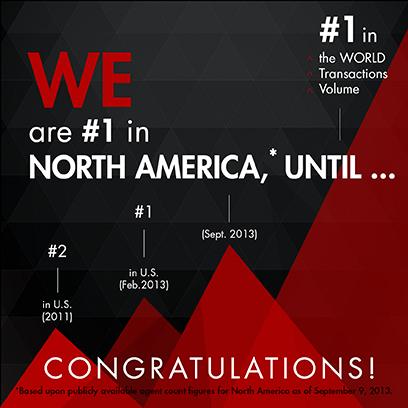The real estate profession changes every day, but the
qualities you find in top-performing practitioners do not. The details may
shift as technology rolls forward, yet the underlying skills are always the
same. If you can master these, you'll be successful in any market.
Skill 1: Meeting New People
The simple fact is that if you never meet anyone new, you
will never have anyone new to sell to. Whether you encounter them for the first
time in person, online, or over the phone doesn't matter. Get one-on-one with
them in a conversation about their needs, and you've at least started down the
path to success.
Skill 2: Making Personal Connections
You don't have to be the best at everything to succeed in
this business. You just have to be competent and likeable.People buy from
people they like. Develop the ability to connect with your clients and make
them trust you, and 90 percent of your sales process is done. Want a quick way
to engender trust? Tell the client something that it's not in your best
interest to tell them. Show them that honestly is more important than anything
to you.
Now, this doesn't mean to tell them that you got sued last
week — that will make people nervous. But it could mean mentioning that the houses
in another neighborhood have the same amount of space and are less expensive.
They know that you get paid more if you sell them a higher-priced house.
Showing them something in their best interests instead of yours makes you
trustworthy.
Skill 3: Following Up on Every Lead
Follow-up is a big area where agents fail. If you aren't
going to take every lead you get and work it to death, then you'll never be a
top performer. Working every lead until it either closes or is clearly not a
lead anymore is critical to building the solid pipeline that's required to keep
your business continually producing. This means that you need a system to make
sure that nothing gets dropped or forgotten. Throw away your Post-it notes;
they should never be used as a place to write down a lead. All leads need to be
kept in one place, and all of them need a minimum amount of information. That
includes:
The person's name
Contact information
What property they contacted you about (or where they came
from if it wasn't from a property)
What their timeframe is for moving
If they're buying, selling, or both
If they're buying, what they're looking for and in what area
What their emotional hot buttons are (what they get excited
or angry about)
If you don't have all of the information you need, don't be
afraid to contact them again for more information. And once you have the
information you need, continue to contact them on a regular basis to make sure
they stay on track. Don't worry that you'll be bothering them—instead, worry
that they would otherwise forget who you are or feel ignored by you.
Skill 4: Asking for What You Want
This is typically a big problem with real estate rookies,
but you'd be surprised how many veterans forget this piece of the puzzle, too.
It's not always easy, but you have to ask for things to get them. Ask for the
sale. Ask for the appointment. Ask for the phone number of the person your
client wants to refer.
Don't wait for people to call you, for the clients to say
they're ready, or for the buyers to tell you that this is the house they want.
Be direct. Ask them, "Is this the house you want to buy?" "I'll
get your house on the market tomorrow if you'll sign right here."
"Which is better for you: Monday at 6 p.m. or Wednesday at 3 p.m.?"
"Why don't you give me your friend's number and then you don't have to
think about it anymore?" All of these are great closing questions used by
some of the top practitioners in the industry.
Skill 5: Setting Appropriate Expectations
Once you have the contracts signed and your clients are
committed to the process, then it's all about meeting expectations. And make no
mistake, there will be expectations—whether you set them or your clients do.
This is why it's important to set those expectations yourself; you don't want
to get blindsided by something the clients decided to expect without consulting
you.
The best real estate professionals are masters at setting
expectations. They know what reasonable timeframes are, and they don't make promises
they can't keep. They let clients know immediately if things need to change and
they set the new expectations quickly and decisively, leaving no room for the
clients to wonder (and worry) what happens next.
Skill 6: Taking Care of Details
You must treat you business like a business. This means that
having a system in place to make sure that deadlines get met, appraisals are
ordered, home inspection responses come in on time, appointments aren't
forgotten, and problems are solved. You should even have systems to make sure
that your clients—and, if you're really smart, the other side's clients—have
handled all of the details that they need to attend to. Hold on to every deal
and work it until it closes, letting nothing go. In saving multiple deals from
certain death each year, top performers improve their closing ratios and
increase their per-hour earnings.
Skill 7: Paying Close Attention to Money
Lots of agents tell me that it's not about the money for
them; it's about the people. And that's great. I love helping people, too. But
if you don't focus on making money, you're not going to make any. Real estate
is your business, your livelihood, and you deserve to be compensated for the
skills and services you provide. If you stop paying attention to the money,
you'll do things like:
Negotiate away your commission.
Not take a referral fee "to be nice."
Work on listings that will never pay you anything close to
reasonable compensation for the amount of work they are because you "feel
bad for the person."
Take overpriced listings so that the sellers will like you.
Not make buyers sign contracts.
Stay with a broker who pays you a below-market split.
All of these things result in you working too hard and not
making what you deserve. It's not your job to right the wrongs of the world.
It's your job to make a living for yourself, preferably a really good one. It's
not about the number of deals you do; it's about how much money you get to keep
when the deals are done.
You have to focus on the money if you hope to be successful.
If you're not making a profit, you're running a charity, not a business, and
you don't get grants like charities do to make ends meet.
You have to keep up with changes in technology, industry
regulations, buyer and seller priorities, and economic conditions. But the
skills that I've listed above will take you further than any new flashy
marketing plan or social media technique. No matter what's going on in real
estate, these skills will be the difference between a good agent and a great one.


